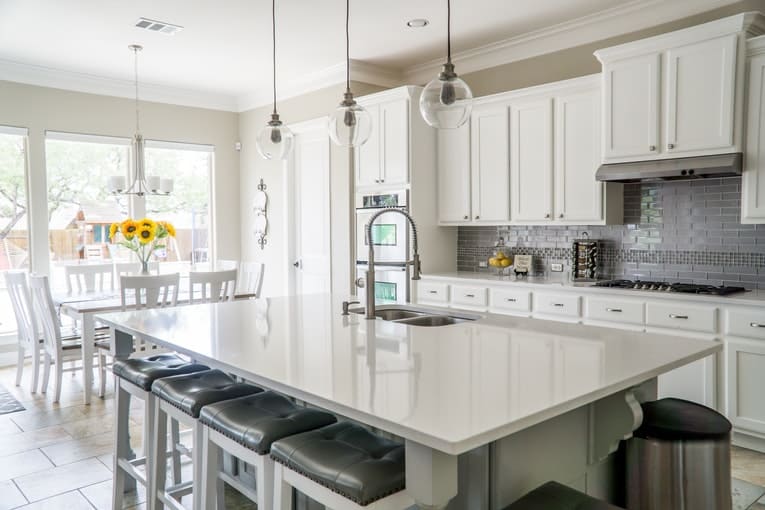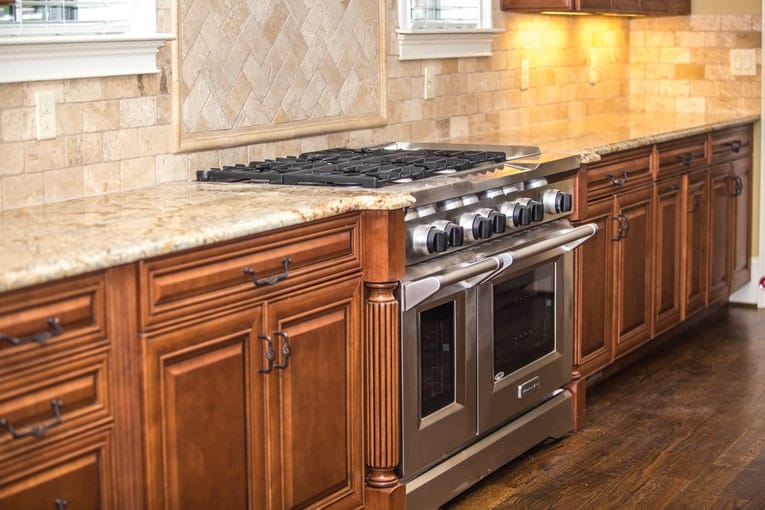This helpful buying guide contains tips on picking color combinations for a kitchen remodel. Includes picking neutral colors, backdrops, and more.
The look of your kitchen sets the tone for the personality of your entire home. The kitchen is a place where family and friends gather, where you create nourishing meals for your family, and where you can show off your decorating skills.
Choosing a color combination might seem simple, but it’s very important because the average kitchen remodel can get pricey. Whether you’re opting for a major overhaul or a few small updates, be sure the remodel will result in the overall look that you want and will remain current for many years to come.
Before deciding on one of the many kitchen color combinations out there, consider these six factors:
1. Choose Neutral Colors
Neutral colors are timeless, so start by choosing base neutral colors you love. For example, a white or tan on the walls blends in and doesn’t distract from other colors in the kitchen. Big items should also be neutral enough to match up to other elements.
Save the bold touches for accessories, window treatments, and wall hangings. For example, if you love hunter green, a good place to utilize the color is in your chair cushions rather than painting your cabinets green.
2. Look at the Big Picture
How will the kitchen mesh with the rest of your home decor? If you have an open floor plan, for example, your kitchen and living room may be visible in the same space. If your living room has a modern design, an old-fashioned country kitchen won’t match.
Step back and look at the personality of your home as a whole before choosing which colors and materials to use in your kitchen. Pull rooms together with a thread of color, and try not to match the shades between your living space and your kitchen perfectly. Looking at the big picture helps you see how your kitchen remodel will fit into your complete space.
3. Consider Lighting
How much light enters your kitchen either via windows or lighting fixtures? If your kitchen is naturally dark, then stay away from dark colors and go for lighter tones.
On the other hand, if your kitchen is bright and well-lit, then dark colors add a bit of sophistication.
4. Decide Between Light and Dark Cabinets
Kitchen cabinets draw the eye when someone enters a kitchen because they take up a lot of space. When choosing a color scheme, deciding between light or dark cabinets is a big part of the equation.
Generally, small spaces benefit from light cabinets, such as white or soft gray, because they open up the kitchen. Similarly, large kitchens can look cozy with a dark color scheme. But you should also let preference be your guide. Dark kitchen cabinets create an elegant, sleek look and are less likely to pick up visible scuff marks from everyday use.
Once you decide between light and dark, a range of colors and materials can create a unique look. Keep in mind that in years to come you may change your floor color or counter color, but well-made cabinets should last around 50 years.
5. Add Neutral Counters
Some trends remain popular year after year in countertops, such as granite or quartz materials. If you’ve ever been in a kitchen dating back to the 1960s or 1970s, then you know why choosing colored countertops is a bad idea. Mustard yellow counters might pop, but they can look dated very quickly.
Instead, stick with neutral colors that compliment your cabinets. One rule of thumb advises alternating between light and dark. So, if you choose dark cabinets, go for light counters. White, black and brown shades tend to go with a lot of different colors as you change your paint, backsplash, or kitchen appliances.
6. Introduce Color with Your Backsplash
A kitchen backsplash offers a chance to introduce color without investing in costly materials. If you choose a color you love today and hate in a year, revamping the backsplash is a relatively simple task.
Many homeowners can update their backsplash as a DIY project every few years. This can be an excellent accent that lets you change up your kitchen’s colors without a major investment.
Color Combinations for Any Kitchen
There’s no right way to color your kitchen, but a few guidelines can keep your project on track. Whether you’re looking for the ideal gathering space or are remodeling to resell, a little research on design principles can go a long way.
Most paint stores and home improvement centers keep a designer on hand. If you’re not sure which colors look best together, ask for professional advice. Consider all the factors above, the opinions of professionals, and then choose the color scheme you love that goes well with the personality of your home.
Holly Welles is a home improvement writer and the editor behind The Estate Update. Her work has been featured on publications like Today’s Homeowner, Homes.com, and Porch.











 Don Vandervort writes or edits every article at HomeTips. Don has:
Don Vandervort writes or edits every article at HomeTips. Don has:




